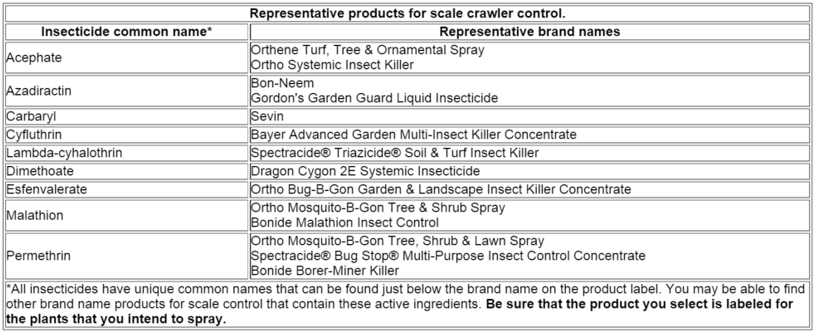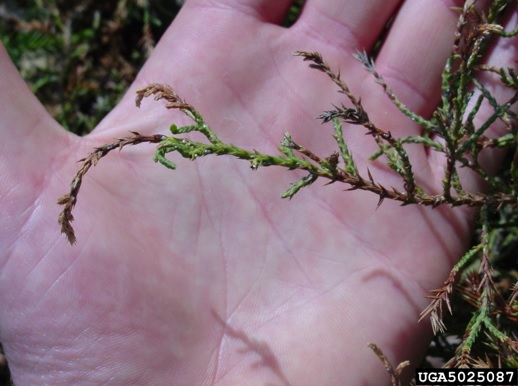Juniper Scale
ENTFACT-429: Juniper Scale | Download PDF
By Jonathan L. Larson, Extension Entomologist and Lee Townsend, Extension Specialist Emeritus
University of Kentucky College of Agriculture
Juniper Scale Fast Facts
- Juniper scales are small scale insects, females are about 1/10th in. wide. Females are circular, while males are more elongated. The female is known for her fried egg like coloration.
- Common hosts for the juniper scale include junipers, cypresses, false cypress, eastern red cedar, and arborvitae.
- Infested plants appear stressed and dingy and heavy infestations can make the plant look like there is snow on it.
- Juniper scale management can be difficult due to their short crawler window but oils, soaps, and contact insecticides can reduce crawler populations. Systemic treatments of dinotefuran in the fall can also help management efforts.
Juniper scales are quite small and live on the needles of their hosts. Females have a distinctive “fried egg” appearance. (Photo by United States National Collection of Scale Insects Photographs , USDA Agricultural Research Service, Bugwood.org)
Potential Hosts
Juniper scales can be found on several important ornamental species such as junipers, cypresses, false cypress, eastern red cedar, and arborvitae. Other recorded hosts include cryptomeria and incense cedar.
Symptoms and Pest Description
Scale insects are “sucking pests”, meaning they use a needle like mouth to siphon fluids from plants. Juniper scales feed on the needles of their host and cause a reduction in rigor of the plant. Infested plants are often described as “dingy”, the needles will be off color and some report that heavy infestations make it look as if the plant has a light dusting of snow on it. The female Juniper scale shell is a circular, flat, armored scale that attacks several species including junipers, cypress and eastern red cedar. The waxy covering of the female is dirty white with a yellow center, resembling a tiny fried egg. The male shell is smaller and narrower. Infested juniper foliage looks dingy and unhealthy.
Infested plants may appear dingy with scale coverings and branch dieback. (Photo by Joseph LaForest, University of Georgia, Bugwood.org)
Life Cycle in Kentucky
Juniper scales pass the winter as fertilized females. Each female will produce about 40 eggs that will hatch over a 10 to 14-day period in about mid-May in central Kentucky. There is one generation each year.
Management
Scales tend to thrive on stressed plants. Following a recommended fertility program and watering regime will promote plant health. However, over-fertilization favors scale buildup. If practical, improve plant sites to reduce stress and promote growth. You can prune out small infestations to try and eliminate the issue or prune out sections of a troublesome scale insect problem in order to make chemical control more feasible.
There are two options when considering management of juniper scales, doing a systemic treatment, or treating the crawlers directly. Whichever you choose, management may take repeated applications over a couple of growing seasons.
Treating with Systemic Insecticides
Dinotefuran (Orthro Tree & Shrub is one possible trade name) is a systemic control option for controlling armored scales such as the juniper scale. A systemic insecticide helps to give you control without reliance on broadcast sprays over much of the plant. This helps keep insecticide residues contained within the plant you wish to protect and helps to ensure the product will affect the pests you are targeting. Dinotefuran can be applied in the spring or fall.
Treating Crawlers Directly
Crawlers are the most susceptible to control stage of a scale insect’s life. Armored scales will coat themselves in a waxy armor once they settle on a spot on the plant. This extra layer of protection often makes insecticide applications ineffective. To treat the crawlers, you should be monitoring for their emergence. The juniper scale’s crawlers are active in May and you can visually inspect for them, or you can place pieces of black electrical tape (sticky side out) or double-sided tape near scale populations and monitor the tape for the crawlers and treat following the initial find.
One organic option for crawler control is to use horticultural oils. Horticultural oils kill by suffocation or after penetrating over-wintering stages of the insect. Consequently, they may not be effective where several layers of scale coverings have accumulated. Insecticidal soaps are long chain fatty acids that kill susceptible insects through direct contact. Like horticultural oils, they require thorough coverage. Soaps leave no residue so repeated applications may be needed for some pests. These products may burn the foliage of sensitive plants, such as Japanese maple, so check the label for information about the plant species that you intend to treat.
A variety of natural and synthetic insecticides are labeled for use as sprays to control scale crawlers on landscape trees and shrubs. While the residual life of these products is generally longer than oils and soaps, timing, coverage, and precautions on damage to some plant species are very similar to those for oils and soaps.
Below are some options for scale insect crawler control.

Evaluating Control
The success or failure of control efforts may not be readily apparent but here are some things to check.
- Live scales should produce a liquid when mashed, dead scales will be dry and not "bleed" when crushed.
- New foliage should have a healthier appearance once the scale burden has been removed. Buds should break a little earlier than when the plant was infested and expanded leaves should have normal color and turgor.
Revised: 2/21
CAUTION! Pesticide recommendations in this publication are registered for use in Kentucky, USA ONLY! The use of some products may not be legal in your state or country. Please check with your local county agent or regulatory official before using any pesticide mentioned in this publication.
Of course, ALWAYS READ AND FOLLOW LABEL DIRECTIONS FOR SAFE USE OF ANY PESTICIDE!
Images: University of Kentucky Entomology unless otherwise indicated


